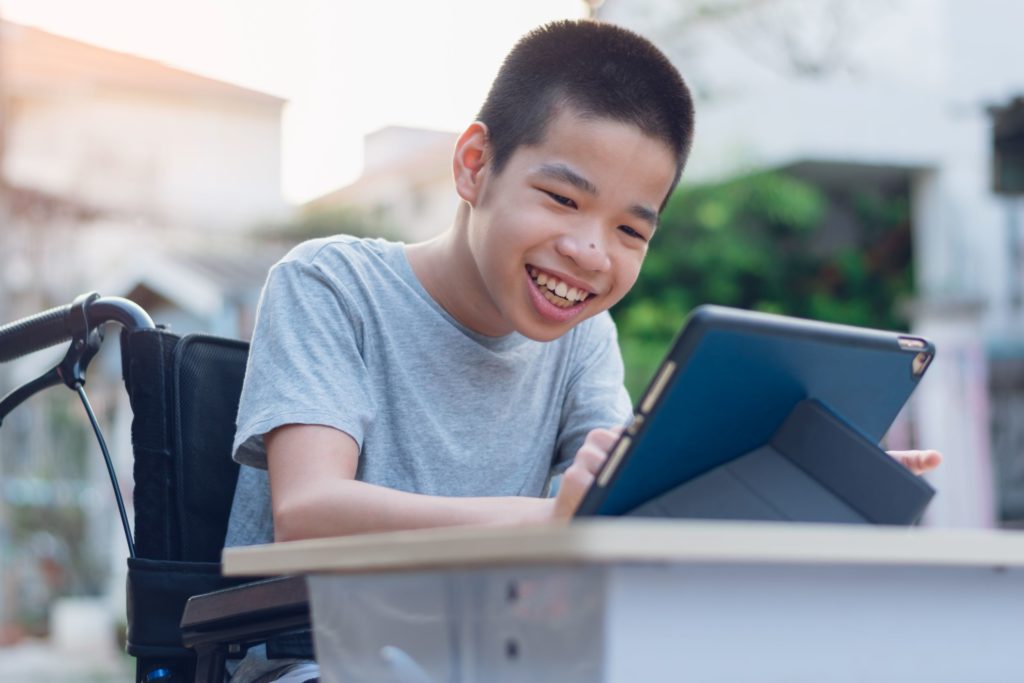Every student comes into the classroom with different skills and abilities. Some do just fine with the differentiation in place; others need additional supports and systems. Assistive technology is one modification schools have to help students with disabilities, playing on students’ strengths and supporting their challenges.
What is Assistive Technology in Special Education?
Assistive technology in special education is support available to help individuals with various types of disabilities. Whether cognitive or physical, different technology in education can help enhance learning for special education students. Assistive technology can refer to any device or equipment that helps bypass or compensate for an individual’s specific learning deficits.
Assistive technology compensates for what a student finds challenges with, but it does not mean the child can’t receive remedial instructional supports as well. Instead, instructional technology in special education paired with assistive technology can greatly support the needs of special education learners. Knowing what assistive technology is in special education, what are some more benefits of assistive technology and instructional technology?
The Benefits of Assistive Technology in Special Education
Assistive technology has enormous benefits for special education students:
- Helps students find success working independently
- Builds confidence in the classroom
- Students who have difficulty in a particular area can do the same work as their peers
Assistive technology addresses many types of learning difficulties such as:
- Math
- Reading
- Writing
- Organization
- Listening
- Memory
Not only does assistive technology have numerous benefits, but so does instructional technology. Where assistive technology helps students with learning difficulties, instructional technology can be used with every child in the classroom. Using computer-based learning, instructional videos, or gamification can significantly increase all student engagement and excitement.
It allows teachers to redefine their teaching and takes their students’ learning to new levels. It also greatly supported teachers during the peak of the pandemic and continues to support them to this day.
How were Special Education Students Impacted by COVID?
Students of all grade levels and abilities were majorly impacted by the COVID-19 pandemic, but students with special needs may have been impacted on a larger scale. According to a survey released in May 2020, 40% of parents of students with special education plans reported that their child was not receiving the support and services they required.
In addition to not having all their IEP components in place during the pandemic, special education students missed out on other key learning opportunities. Routines were disrupted, crucial social skills were halted, and life skill learnings were exacerbated.
When it came to assistive technology, many did not have immediate access to everything they needed for meeting their learning needs, such as:
- Online social skills
- Adaptive equipment
- One-on-one paraprofessionals
If the pandemic did anything positive for the world of special education, it was bringing to life just how vital student access to assistive and instructional technologies truly is.
Examples of Assistive Technology in Special Education and How to Use Them
Hearing and Listening
One of the most popular classroom assistive listening devices is an F.M. system. The teacher wears a transmitter around their neck that connects to a child’s ears or hearing aids. This allows them to hear their teacher better no matter where in the room they are located. It also helps the teacher not put the students on the spot by raising their voice to get their attention.
Putting captions on videos shown in class or assigned as homework can also be helpful for students who need assistance with hearing and ensures the media is inclusive for their needs.
Virtual Reality Technology
It’s not very feasible to take a field trip to the Amazon rainforest or to visit The White House. With the use of virtual reality field trips, now students can from the comfort of the classroom. Whether this educational technology is used in the special education setting or not, virtual and augmented reality tools allow students to learn through visual experiences that were otherwise not possible. And for special education students, this can be even more meaningful.
Virtual reality can transport students into situations and events they may otherwise never have the opportunity to be a part of. Think about the experience of running in a track meet using their (virtual reality) legs instead of their wheelchair or digging for dinosaur bones without the use of their prosthesis. Virtual reality tools can excite and energize students and give them experiences they may never have dreamed of!
Reading and Writing
Reading and writing can be a frustrating subject for all levels and abilities of learners. But for students with learning disabilities (dyslexia, ADHD, and more), it can be extremely challenging.
There are assistive technologies out there that can help eliminate the frustration of reading and writing. Predictive typing tools, proofreading, and read-aloud captions can reduce the number of errors when writing. This can help learners feel more confident and competent in expanding their reading and writing skills.
Mobility Aids
Mobility aids are one of the first things that come to mind when thinking of assistive technology. Wheelchairs, scooters, or prosthetic devices can help students get from point A to point B inside their school building and are usually a major part of their lives.
They also are a big part of adaptive P.E. activities. Students can use scooters to play hockey or large blow-up balls to play soccer. Mobility aids can be a part of a special education student’s daily medications or the adaptations planned for their physical movement activities.
Every student comes into the classroom with different skills and abilities. Some need more modifications than others, especially when it comes to special education. With assistive and instructional technology, students can feel confident in their abilities. They can reach their goals and be successful in the classroom by embracing the technologies designed for them.
Interested in making an impact in special education? Check out our special education graduate programs and get started today!




